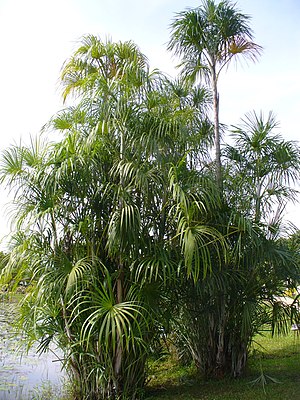Mauritiella
| Mauritiella | ||||||||||||
|---|---|---|---|---|---|---|---|---|---|---|---|---|

|
||||||||||||
| Systematics | ||||||||||||
|
||||||||||||
| Scientific name | ||||||||||||
| Mauritiella | ||||||||||||
| Burret |
Mauritiella is a palm genus native to tropical South America. The trunk of the fan palm is covered withrootthorns.
features
The representatives are medium-sized, multi-stemmed fan palms with upright trunks. The trunk is partially covered by the dead leaf sheaths, the lower areas are exposed. The internodes are often covered with thorn-like adventitious roots . The representatives are dioeciously segregated .
The number of chromosomes is 2n = 30.
leaves
The leaves are divided in the shape of a hand. They are medium in size, reduplicate and costapalmat for short. The petiole is clearly developed, smooth, unreinforced and often covered with wax. The leaf blade is approximately circular in outline. The blade is divided almost to the point of attachment along abaxial folds. The segments are numerous and simply folded. Its tip is very short in two parts. The upper side of the leaf is usually bare, the underside is usually covered with white wax and scales.
Inflorescences
The inflorescences are usually single and between the leaves (interfoliar). The male and female inflorescences are quite similar. The inflorescence stalk is short, the cover sheet short, tubular, two-keeled. The numerous bracts on the peduncle overlap and are distich. The inflorescence axis is much longer than the stalk. The bracts on the axis are similar to those on the stem, each bearing a hanging or protruding side axis of the first order. On the lateral axis there is a short, double-keeled, tubular cover sheet and one to a few empty distich bracts. The following bracts are tubular and short, each has a very short flower-bearing axis (rachilla).
The male rachillae are kitten-like . The basal tubular double-sided cover sheet is followed by closely spaced, spirally arranged bracts, each of which contains a single male flower with a tubular double-sided bracteole.
The female rachillae are very short and also kitten-like. The bracts are spirally up to almost two lines and each have a single female flower.
blossoms
The male flowers are symmetrical. The calyx is tubular and briefly three-lobed. The crown is tubular at the base and has three long, leathery lobes that are considerably longer than the calyx. The six stamens have thick, angular, long stamens. The anthers are oblong, basifix and latrors. The stamp rudiment is very small.
The pollen is spherical, the germ opening is monoporous. The longest axis measures 40 to 55 micrometers.
The female flowers are larger than the male. The calyx is tubular and briefly three-lobed. The crown is fused in the lower third to half. The six staminodes are laterally fused with their two stamens. The gynoeceum is triple with three ovules. The surface is covered with vertical rows of scales. The style is short and has three scars. The ovules are anatropic .
Fruits and seeds
The fruit is round, mostly solitary and has apical remains of scars. The exocarp is covered with numerous vertical rows of reddish-brown scales. The mesocarp is rather thick and fleshy. The endocarp is hardly differentiated. One seed is usually formed for each fruit. This is round to ellipsoidal, sits basal. The testa is thin, the endosperm homogeneous.
Distribution and locations
The species occur in northern South America. They grow predominantly in the lowlands and are characteristic representatives of the banks of black water rivers .
Systematics
The genus Mauritiella Burret is placed within the family Arecaceae in the subfamily Calamoideae , the tribe Lepidocaryeae and the Subtribus Mauritiinae.
The Royal Botanic Gardens, Kew's World Checklist of Selected Plant Families recognizes the following species:
- Mauritiella aculeata (Kunth) Burret : The distribution area extends from southeastern Colombia to northern Brazil.
- Mauritiella armata (Mart.) Burret : The home is tropical South America.
- Mauritiella macroclada (Burret) Burret : The homeland is western Colombia and western Ecuador.
- Mauritiella pumila (Wallace) Burret : The home is the southeastern Colombia and the southwestern Venezuela.
The generic name Mauritiella is the diminutive of the genus Mauritia , with which it is closely related.
literature
- John Dransfield, Natalie W. Uhl, Conny B. Asmussen, William J. Baker, Madeline M. Harley, Carl E. Lewis: Genera Palmarum. The Evolution and Classification of Palms . Second edition, Royal Botanic Gardens, Kew 2008, ISBN 978-1-84246-182-2 , pp.
Individual evidence
- ↑ a b c d e Rafaël Govaerts (Ed.): Mauritiella. In: World Checklist of Selected Plant Families (WCSP) - The Board of Trustees of the Royal Botanic Gardens, Kew . Retrieved July 31, 2018.